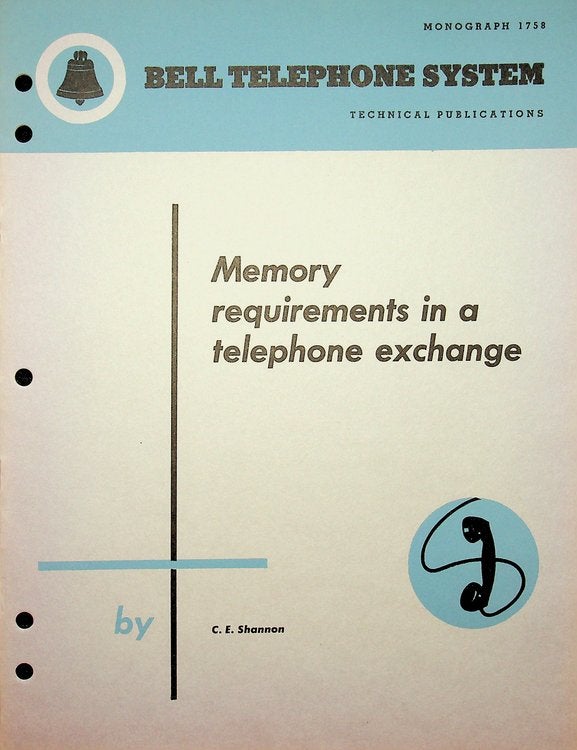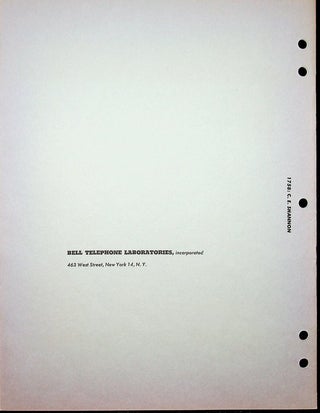Memory Requirements in a Telephone Exchange
New York: Bell Telephone Laboratories, Inc. October 1950. First Separate Edition. 1-7, [1-blank] pages. 21.3 x 27.5 cm (8 3/8 x 10 7/8 inches). Stapled wrappers, printed in grey, light blue, and black. 5 hole punched at the spine, as issued. The first separate edition. A bright clean copy. Fine. Wraps. [28149]
This is the first separate edition, published in the Bell Telephone System Technical Publications Monograph series, #1758. The research paper was first published in the Bell System Technical Journal, Vol 29, July, 1950, pages 343-349.
"The basic function of an [ telephone ] exchange is that of setting up a connection between any pair of subscribers. In operation the exchange must 'remember' in some form which subscribers are connected together until the corresponding calls are completed. This requires a certain amount of internal memory, depending on the number of subscribers, the maximum calling rate, etc." (first paragraph)
Shannon derives a formula M = 2S log N and interprets it in terms of information theory (utilizing his seminal paper 'A Mathematical Theory of Communication').
Today we might wonder why knowing how much memory a telephone exchange needs was important. In the 1950s central office telephone switches (the machines that ran the telephone network in cities or large companies) were mostly mechanical or electromechanical. Their electrically connected components (look up Strowger or Crossbar switches for more information) allowed just basic call connections. Shannon's paper created the theory that enabled engineers to properly size the memory components that would eventually allow fully electronic switches. Fully electronic telephone switches were very important because they enabled other significant business features that the telephone companies could charge for - caller id, three way calling, call forwarding, and eventually revolutionary tools like voicemail. And since electronic memory was a very expensive component of any system for many years, optimizing this resource was a key profit consideration. While the first fully electronic switch, the #1ESS, wasn't installed until 1965, Shannon's paper provides an early theoretical building block - a piece of the puzzle that helped enable the modern telephone network.
Provenance: From the files of Claude E. Shannon (unmarked).
Literature: Sloane and Wyner, "Claude Elwood Shannon Collected Papers" #56. Hook and Norman, "Origins of Cyberspace" #883.
COLLECTORS NOTE: The Bell System Monograph series is not an offprint series although it is often incorrectly referred to in this manner. It was rather a publication of Bell Telephone Laboratories used to widely distribute (primarily to libraries and large corporations) research articles written by Bell System employees in a variety of widely dispersed publications (including but certainly not limited to the Bell System Technical Journal). The series therefore represents a much broader selection of Bell System research than the Bell System Technical Journal did. Collectors prize this series as they are often (but not always) the first separate appearance of a paper and hence are the closest one can get to the elusive and ever sought after offprint.
ITEM SOLD




